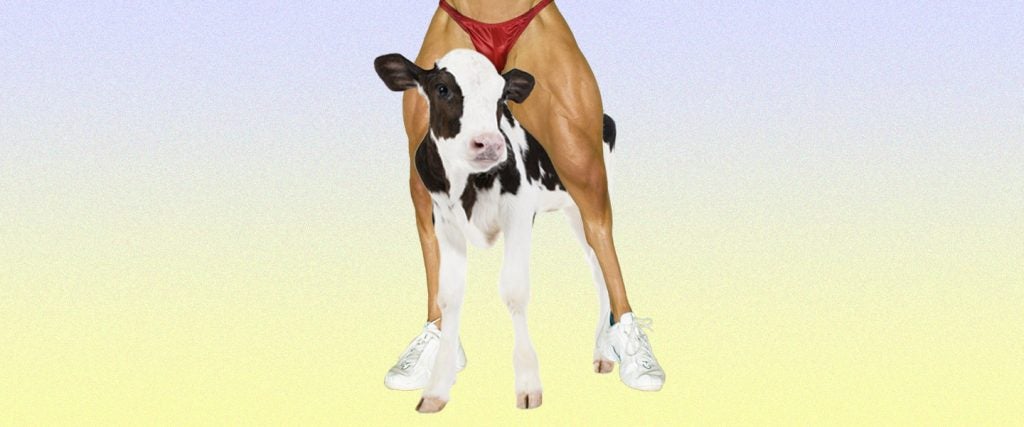One of my favorite wrestling promos of all time was when Dudley Boyz manager Joel Gertner grabbed the microphone in front of an ECW audience and remarked that his calves were so big that they could be “mistaken for full-grown cows.” It’s creative, it’s preposterous and it also touches upon a delicate subject: Of the body parts that we often try to coax growth out of, our calves tend to be among the most uncooperative.
I endured several hour-long Sunday afternoon leg-training sessions with members of the Bally’s training staff, and no matter how thorough our training was — and no matter how impressive my gains were otherwise — my calves always remained tiny and inconsequential. “What am I doing wrong?” I asked Chris, the 6-foot-4, corn-fed giant on the training staff, who was once offered a scholarship to play tight end for the University of Missouri. “I’m doing everything you’re doing, and my calves won’t grow at all.”
“It’s all genetics,” explained Chris, dismissively. “You know how your abs are better than mine? That’s genetic. Same thing with my calves and yours. It’s all genetics.”
I refused to concede the point about abs, because I ingested way fewer calories than Chris on a regular basis, and also did far more cardio (when it comes to fat loss, those two things go together like baby back ribs and barbecue sauce). However, his point about calves had me curious as to the legitimacy of his statement. I preferred to think that everyone possessed equal muscle growth potential in each part of their anatomy, but common sense and two good eyes told me this wasn’t the case. It appeared that calf size is one of the areas in which I drew the short straw, genetically speaking, and no amount of calf raises was going to pull me out of the hereditary hole that my DNA had predestined me to dwell in.
Is there nothing I can do about my puny calves?
You’ll never know unless you try, but there are a few things you should know first.
There’s no need to speculate any further about the role of genetics in calf-muscle growth, because the mixture of factors that produces large calves is easily identified and diagnosed. First and foremost, it helps to have a large muscle belly in the calves. No, I’m not suggesting that your calves each have their own HGH-enhanced six pack lurking within them. Instead, I’m referencing the widest part of an individual cluster of muscle fibers. Some people simply have larger muscle bellies than others, and this is owed solely to the genetic lottery.
Next we need to consider the length of the bones and the Achilles tendons those muscle bellies are connected to. “Natural Bodybuilder of the Decade” winner Ron Williams has large muscle bellies in his arms, accompanied by a very short set of humerus bones. What this ultimately amounts to for him — even long after his competitive posing days — is a set of massive biceps that he couldn’t get rid of if he tried.
This sounds totally unfair!
If you’re upset already, then I need to warn you that the news is going to get much worse before it gets any better.
The next thing those of us with tiny calves need to reckon with is the insertion point of the calf muscle. If your calves have a high insertion point, coupled with long Achilles tendons, it almost certainly ensures that your calves will never pack on substantial mass.
Not all hope is lost, though, because there is an upside: What your calves may lack in girth, they’re likely to make up for in performance. Long calves have been credited with a portion of Kenyan distance-running dominance, which is owed to the springiness and power contained within such calves. The Kenyan runners also have plenty of high-achieving company in the tiny-calf club, including the fastest man alive. There may not be anything impressive about Usain Bolt’s calf muscles, but everyone was beside themselves over his 100-meter world record time.
Finally, there’s muscle fiber variance to account for. While there are averages to the fast- and slow-twitch muscle fiber percentages of most people’s calf muscles, some folks possess slow-twitch muscle fiber percentages that are sky high, and these muscles — although durable — are nearly impossible to spur into growth.
It sounds like you’re telling me to give up!
By no means would I ever do that! I’m all about improvement, and just because a muscle group may not be responsive in terms of growth, it doesn’t mean that portion of your body can’t undergo a notable increase in strength. There are accomplished weightlifting team members with calves that are nothing to write home about, but that doesn’t mean their calves are lacking in explosive power. So you can rest assured that calves are factored into their training, even if they refuse to grow.
And again, always remember Usain Bolt. If pint-sized calves are sufficient to propel the fastest man in human history to victory, they ought to be adequate for you, too.

